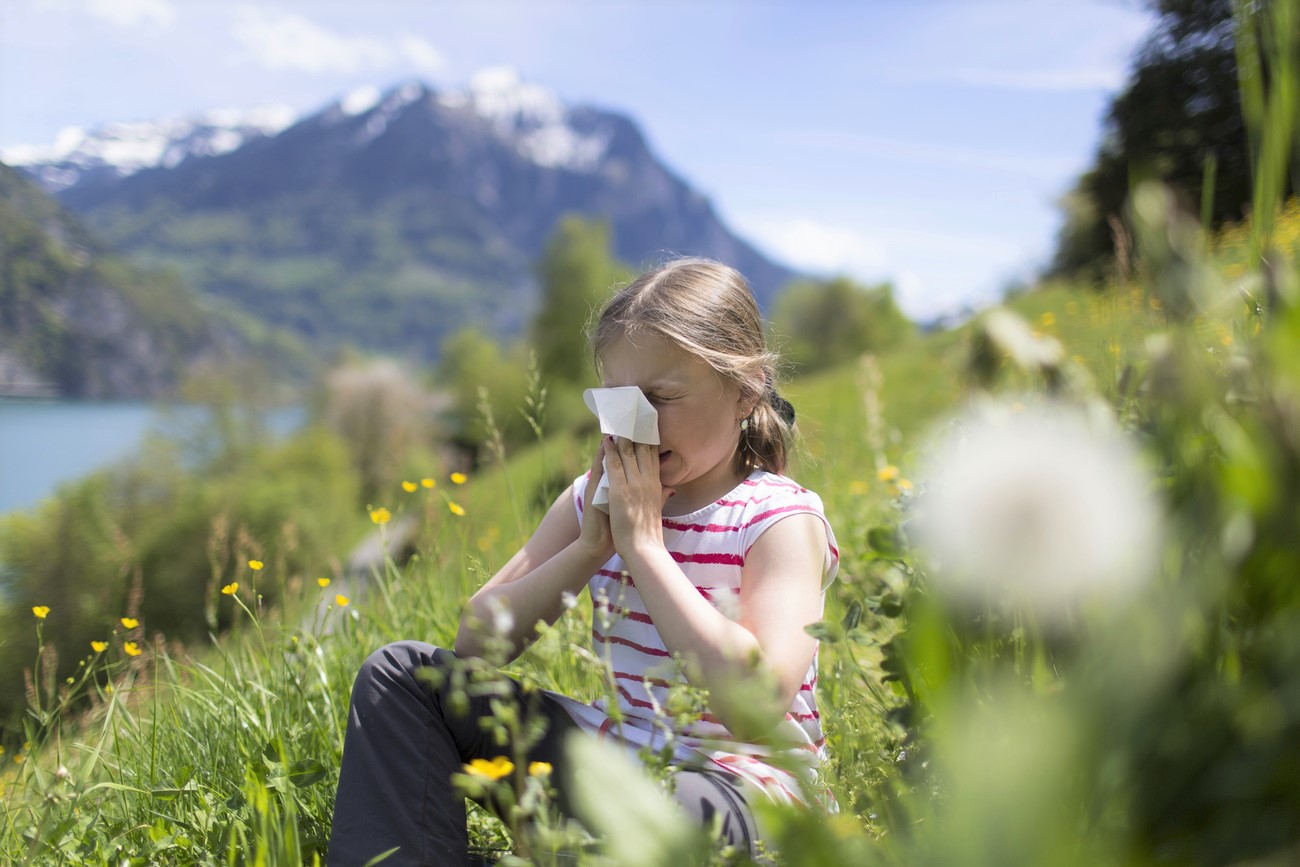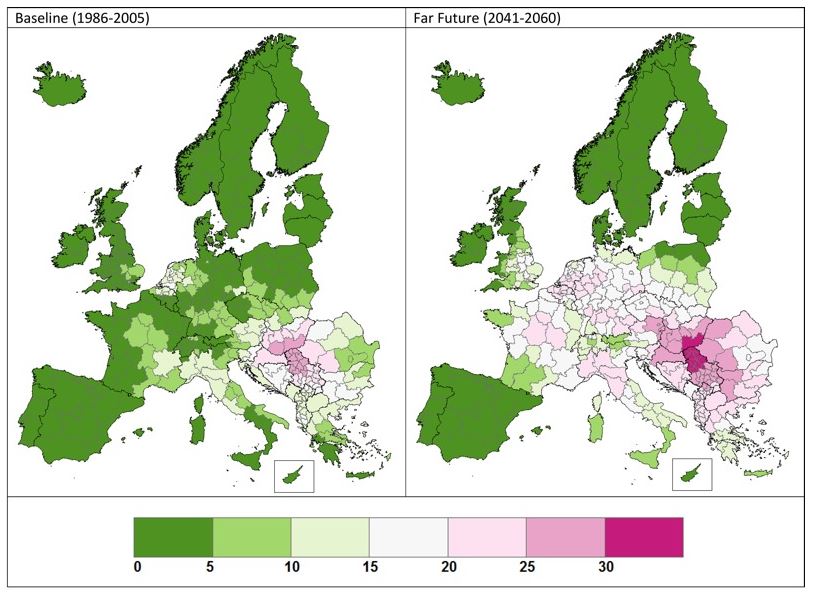
New technology brings relief to people with pollen allergies

The number of people suffering from hay fever worldwide is steadily on the rise. An innovative measuring device used and tested in Switzerland can help improve pollen forecasts, bringing fresh hope to those afflicted.
Red eyes, runny nose and frequent sneezing. These are common symptoms for the around 1.7 million people in Switzerland who are allergic to tree or grass pollen. This is about 20% of the population, on a par with levels found worldwide.
Bernard Clot knows what it is like to live with hay fever. As a child, he could not play outdoors with his friends in the summer as he was prone to allergic asthma attacks. “It was a difficult time,” says the 60-year-old. The allergy disappeared several years ago thanks to desensitisation therapy, but pollen continues to be part of his daily life.
Clot is a biometeorologist at the Federal Office of Meteorology and Climatology, known as MeteoSwiss. He studies the impact of weather phenomena and air characteristics, such as pollen concentration, on living beings.
Partly because of pollution and climate changeExternal link, more and more people are now allergic to pollen and other microscopic particles of biological origin present in the air (bioaerosols). And the problem is not just a health one. In Switzerland alone, the related yearly direct costs (doctor’s visits, drugs and treatment) and indirect costs (absence from work and loss of productivity) are estimated at between CHF1 and 3.5 billionExternal link ($1.1 and 3.9 billion). “Having up-to-date and reliable pollen data is therefore crucial,” says Clot.
How is pollen in the air measured?
Up on the roof of the MeteoSwiss aerological station at Payerne, in French-speaking Switzerland, a high-tech device sucks in the air and all the particles it contains. The pollen grains are driven into the measuring chamber, where two ultra-fast cameras and lasers of different wavelengths determine their shape and size.
The data collected is analysed using AI algorithms. These can selectively recognise the most allergenic pollens, such as grass and ragweed.
The information thus obtained on pollen concentrations in the air can help improve short- and medium-term forecasts, to the benefit of millions of allergy sufferers in Switzerland and across Europe. Researchers and doctors can also use the back data to evaluate the effectiveness of treatments.
MeteoSwiss coordinates EUMETNET AutoPollenExternal link, a European programme seeking to automate and standardise pollen monitoring across the continent. For, as Clot says, “pollen does not stop at borders.”

Detecting pollen 5,000 metres high
The Payerne aerological station also has a new instrument on its roof, developed by the Swiss Federal Institute of Technology Lausanne (EPFL) together with technological research institutes in Greece, which can shed light on what is going on high in the air.
The prototype currently being tested in Payerne sends a laser pulse upwards and can detect the presence and concentration of particles, biological or otherwise, up to an altitude of 5,000 metres. Thus, in May and June, it found that Swiss air was laden with smoke particles from wildfires in North America. There are only four such instruments in operation worldwide, and the one in Switzerland has the most advanced capacity, according to EPFL.
This technology can help provide insight into how pollen spreads over long distances. It can also feed into research on how the different particles found in the air, including bacteria, affect human health and the climate, explains Athanasions Nenes, director of EPFL’s laboratory of atmospheric processes and their impacts. The effect of these particles on human health is “sorely underestimated”, the scientist regrets, and gaining a better understanding of what is happening above our heads is now key.
A revolution in automated pollen measurement
The Swiss pollen measurement system is fully automated and provides information in real time.
This is a major revolution compared to manual measurement, the standard method used worldwide until a few years ago and still used today in many countries, Clot explains. Under the manual system, the pollen grains are deposited on a plastic strip attached to a metal disc and then analysed under a microscope. The data is only available after seven to nine days.
In Japan, pollen allergy is considered a national emergencyExternal link, and the country was long known for having the most advanced automated measurement system, according to Clot. Unlike the Swiss network, however, the Japanese one only detects two types of pollen – Japanese cedar and cypress – which are responsible for most of the allergies in the Japanese population.
But some people are also allergic to grasses and ragweed, so the instruments used in Switzerland could also prove useful for Japan, Yoshie Nakamura, the spokesperson for Japan’s national weather service, told SWI swissinfo.ch.
A network that recognises seven types of pollen
Switzerland is the first country in the world to set up a national network for the automatic measurement of different pollen types. It has been up and running since early 2023 and consists of 15 monitoring stations in the country’s most important climatic and vegetation regions.
The levels of seven pollen types (hazel, alder, birch, ash, beech, oak and grass) are published on the MeteoSwiss website and updated every hour. Allergy sufferers can also consult the pollen radar for the expected evolution until the next day, just as one might check the weather forecast.
The system is also designed to identify other allergenic particles, such as fungal spores, Clot explains. “The goal is to improve predictions so that people with allergies can live better,” he says. In the future, the spectrum of recognised particles will be broadened to include pollutants, microplastics and other particles that can cause disease in crops.
Pollution and climate behind spike in allergies
By 2050, half the world’s population will suffer from an allergic disorder, according to the World Health Organization. This is the result of a mix of environmental and lifestyle factors. For instance, greater hygiene reduces our “resistance” to external agents.

More
Looking for allergy relief in the pollen-free Swiss Alps
Several studies, including one carried out in BaselExternal link, point in particular to an increase in the pollen produced by trees. In Europe, forests have been expanding since the 1990s, although this only partially explains the pollen evolution, according to Clot.
Rising temperatures and increased CO2 in the atmosphere spur plants to produce more pollen. The duration and intensity of the pollen season has increased for several allergenic plant species, notes Marloes Eeftens, a researcher at the Swiss Tropical and Public Health Institute, in a 2021 studyExternal link. As a result, “allergic people not only suffer for a longer period of time but also react more strongly to these higher concentrations.”
Pollution also plays a role. A tree growing in smog produces pollen that contains more allergenic proteins and irritants, according to Clot. Added to this, some pollutants damage the mucous membranes of the respiratory system and reduce people’s defensive barriers. Allergens then penetrate the body more easily and cause stronger allergic reactions.

Real-time data to escape pollen
Personalised therapies, such as medication or the desensitisation followed by Clot, can be effective. The first step, however, is to avoid contact with allergens, and here the instruments being used and tested in Payerne can prove extremely useful.
Real-time data helps allergy sufferers in their daily lives. They can plan their activities and medicine intake according to pollen forecasts, opting for indoor sports rather than jogging outside, for example; or they can change a planned trip to the mountains for one to the plains, or vice versa.
This impact is what keeps Clot motivated. During a recent public information day in Bern, many allergy sufferers came up to the MeteoSwiss stand to thank him and his colleagues for their work. “That is by far the best reward,” says the expert.
Edited by Sabrina Weiss and translated from Italian by Julia Bassam

In compliance with the JTI standards
More: SWI swissinfo.ch certified by the Journalism Trust Initiative





























You can find an overview of ongoing debates with our journalists here . Please join us!
If you want to start a conversation about a topic raised in this article or want to report factual errors, email us at english@swissinfo.ch.